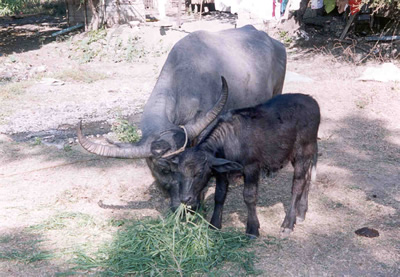by Danilda Hufana-Duran
Water buffalo (Bubalus bubalis) is an important livestock among farmers in the South-East Asian nations providing milk, meat and draft power. There are two types of water buffaloes; the river (2n=50) type, used primarily for milk and meat found mostly in Indian continent, and the swamp (2n=48) type, primarily used for draft and only secondary for meat and milk and found in most of South-East Asia.
In countries where swamp-type is the dominant buffalo breed, infusion of imported river type has been initiated to improve milk and meat production. However, the risks and high costs of live animal importation plus the inherent reproductive problems such as delayed age of puberty, less pronounced signs of estrous, seasonal anoestrus, long period of post-partum anoestrus, and low conception rates limit the propagation of upgraded animals. Assisted reproductive technologies like artificial insemination have been introduced to overcome the reproductive inefficiencies and to increase genetic gain but these techniques require long years of continuous backcrossing before coming up with the desired animal genetics.
Attempts to enhance genetic improvement in water buffalo through the use of superovulation and embryo transfer technology capitalizing on the production potentials of superior animals have been initiated. However, low efficiency manifesting relatively low yield of in vivo-derived embryos resulted to a shift in interest to in-vitro embryo production technology.
In this context, techniques on in-vitro production and vitrification of embryos were studied to develop tools for facilitating water buffalo genetic improvement. The methods used in cattle and mice were validated and modified to suit the water buffalo requirements. Oocytes from slaughtered Murrah buffaloes were collected and matured in-vitro for 24 h. In-vitro matured oocytes were in-vitro fertilized using capacitated frozen semen from top progeny tested bull for 6-8 h. Fertilized oocytes were in-vitro cultured for the development of pre-implantation stage embryos in 8 days. Developed morula to expanded blastocysts stage embryos were cryopreserved by vitrification techniques. To assess the viability of the in vitro-derived vitrified embryos (Study 1), post-warmed embryos were further cultured in-vitro to assess hatching rate, and through in-vivo by the transfer to a riverine recipient. To assess the efficiency of the techniques as tool for genetic improvement, warmed embryos were transferred to swamp buffaloes (Study 2) or transferred as 2-3 embryos to recipient dam to enhance twinning (Study 3).
Results in Study 1 showed 83.10% (59/71) hatching rate in-vitro, 16.36% (9/55) pregnancy rate and 10.91% (6/55) calving rate. In Study 2, four (10.0%) normal riverine calves were delivered to term by swamp recipients out of which three (7.5%) were healthy and alive born through normal delivery while one (2.5%) was a case of stillbirth. Efforts to enhance twinning (Study 3) have resulted to 26.9% calving rate of which 3.8% (1/26) as twin and 19.2% (5/26) as single births.
These results demonstrate for the first time the success of in-vitro production and vitrification of embryo in water buffalo suggesting that the techniques are promising tools for water buffalo genetic improvement.
 |
| Figure 1. River buffalo calf (2n=50) born by swamp buffalo recipient (2n=48) out of the transfer of in-vitro derived vitrified embryos. |
Keywords: Reproductive biotechnology, in vitro embryo production, vitrification, genetic improvement
__________
Danilda Hufana-Duran is currently affiliated with the Philippine Carabao Center and the Department of Agriculture, University of Tsukuba. She is specializing on the field of reproductive biotechnology.
NOTES:
1. This research was supported by grants from the Department of Science and Technology-Philippine Council for Agriculture Resources Research and Development, and the Department of Agriculture in collaboration with the Frigorifico Allana Limited India. Appreciation goes to Dr. S. Hamano (Animal Biotechnology Center, LIAJ), Dr. Y. Tsuzuki (Miyazaki University), Dr. Kasai (Kochi University) Dr. Y. Kanai (University of Tsukuba), Dr. Y. Takahashi (Hokkaido University) for technical support and assistance.
2. This abstract also appears in ISKO jointly published by AFSJ, FAST, and STACJ.